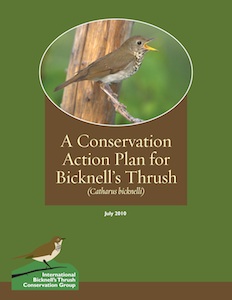White River Junction, VT – An international conservation group today unveiled a plan to protect one of North America’s most rare and vulnerable songbirds, the Bicknell’s thrush, across its entire range from Canada to the Caribbean.
 The International Bicknell’s Thrush Conservation Group (IBTCG), an alliance of scientists, conservationists and governments, proposes to increase the global population of Bicknell’s thrush by 25 percent over the next 50 years, mostly by preventing further loss of its breeding and wintering habitats.
The International Bicknell’s Thrush Conservation Group (IBTCG), an alliance of scientists, conservationists and governments, proposes to increase the global population of Bicknell’s thrush by 25 percent over the next 50 years, mostly by preventing further loss of its breeding and wintering habitats.
The enigmatic thrush, with its swirling song and speckled breast, breeds in specialized mountainous habitat in eastern North America and winters in threatened forests of the Caribbean Greater Antilles. Threats to the songbird, which is declining over portions of its range, include atmospheric pollution, climate change and loss or degradation of its forest habitats.
“We now have an opportunity to save this remarkable species, a migratory songbird found in such limited numbers that its future is in doubt,” said Chris Rimmer, director of the Vermont Center for Ecostudies and a lead author of the conservation plan. “This innovative plan offers tangible actions based on sound science and measurable results.”
A Conservation Action Plan for Bicknell’s Thrush establishes a course of conservation and research over the next five years designed to boost the worldwide Bicknell’s Thrush population. Actions include:
- Partnering with timber companies and managers of public lands in North America to develop and implement practices that enhance Bicknell’s Thrush breeding habitat, which includes high-elevation forests of New England, New York, Quebec, New Brunswick and Nova Scotia.
- Conducting scientific research to monitor and predict the impacts of climate change on Bicknell’s thrush habitat.
- Improving the protection of currently occupied winter habitat and develop management plans for key forested areas on Hispaniola, including restoration of degraded habitats.
- Strengthening links with local partners in the Caribbean and expand funding for on-the-ground conservation projects throughout the winter range.
The IBTCG estimates the worldwide population of Bicknell’s thrush at 126,000 or fewer birds, a diminutive number for a songbird species. Although U.S. populations declined during the past two decades, numbers have remained stable for the past seven years. However, Bicknell’s thrush in Maritime Canada (Nova Scotia and New Brunswick) plunged 15 percent annually during the same period.
“The Committee on the Status of Endangered Wildlife in Canada recently recommended that Bicknell’s thrush be designated as federally Threatened,” said Becky Whittam, Atlantic Canada Program Manager for Bird Studies Canada. “While a troubling affirmation of the species’ precarious status, this designation, if accepted, will bring much needed attention to the Bicknell’s thrush and its habitat. The Conservation Action Plan released this month should jump start the process of recovering this globally vulnerable species across its entire range.”
The IBTCG will launch implementation of its ambitious Plan via a 3-day international meeting in Santo Domingo, Dominican Republic during early November of 2010. As many as 50 key conservation partners from the U.S., Canada, and several Caribbean countries will assemble to discuss tangible solutions to the challenges facing conservation of Bicknell’s thrush across the hemisphere.
The International Bicknell’s Thrush Conservation Group is an alliance of scientists, natural resource managers, and conservation planners advancing the study and conservation of Bicknell’s thrush through sound science and international cooperation.
The principal agencies and organizations involved in developing the plan include U.S. Fish and Wildlife Service, Vermont Center for Ecostudies and Bird Studies Canada in close collaboration with Canadian government and non-government partners. Collaborators also include conservation partners on the island of Hispaniola, which is believed to support up to 90 percent of the species’ global population in winter.
